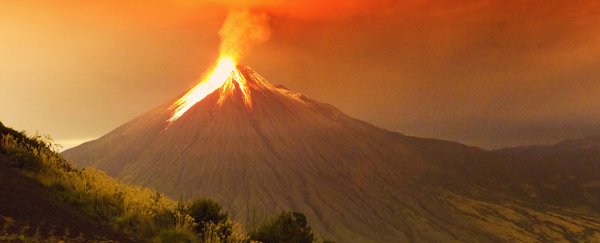A massive extinction event that cleared the way for dinosaurs to spread and diversify at the end of the Triassic period was caused by periods of volcanic eruptions.
That's the conclusion of new research on a vast field of igneous rock covering four continents, supporting a hypothesis that states global climate change was responsible for the end of three quarters of the world's species 200 million years ago.
The study led by scientists from Oxford University supported suspicions that a series of volcanic pulses responsible for producing a vast mass of igneous rock called the Central Atlantic Magmatic Province (CAMP) caused widespread climate change in line with a global extinction event.
CAMP is a vast spread of igneous rock that covers about 11 million square kilometres (about 4.2 million square miles), laid down by periods or 'pulses' of volcanic activity around 200 million years ago.
The province of rock has long since broken up as tectonic plates have slid over the Earth's surface, separated out over four continents stretching across both hemispheres.
Previous studies had already suggested a link between the volcanic activity that caused CAMP and 600 thousand years of intermittent rising and falling carbon dioxide levels in the atmosphere.
But other research found no indication that carbon dioxide fluctuated. Not only that, other geological processes also needed to be ruled out before it could be concluded that the apparent pulses of CO2 concentration were definitively caused by periods of volcanic activity.
So the scientists worked in collaboration with the Universities of Exeter and Southampton to take a closer look at the mercury levels in sediment deposits taken from UK, Austria, Argentina, Greenland, Canada, and Morocco.
Mercury levels are released as a trace element in volcanic gases, so serve as a fairly reliable indicator of activity as it spreads through the atmosphere before being absorbed by organic processes.
The mercury levels in five of the six samples analysed by the team showed a large increase in the element coinciding with the start of the Triassic extinction event, with peaks matching up with previously established increases in atmospheric carbon dioxide.
"These results strongly support repeated episodes of volcanic activity at the end of the Triassic, with the onset of volcanism during the end-Triassic extinction," says lead researcher Lawrence Percival.
As we're too well aware of today, increased levels of carbon dioxide can have a dramatic impact on land and marine ecosystems by trapping heat and increasing ocean acidity.
On the other hand, fine particles released by eruptions can suspend in the atmosphere, reflecting sunlight and causing temperatures to drop.
Nobody is certain which scenario was responsible, though studies such as this add weight to the hypothesis that global warming from high levels of carbon dioxide was at work.
The extinction event that marked the boundary between the Triassic and Jurassic periods was one of the biggest to shake our biosphere – an estimated 76 percent of species were wiped out, including the majority of a group of dinosaur ancestors called archosaurs.
It's not clear why a number of early dinosaur species survived, but alongside mammals and a number of amphibian species they swiftly evolved to fill the gaps left behind.
"This further evidence of episodic emissions of volcanic CO2 as the likely driver of the extinction enhances our understanding of this event, and potentially of other climate change episodes in Earth's history," says Percival.
While it's a small consolation knowing that life can flourish in the wake of global climate change, taking note of past increases in carbon dioxide suggests we could be in for a rough ride in the meantime.
This research was published in PNAS.
